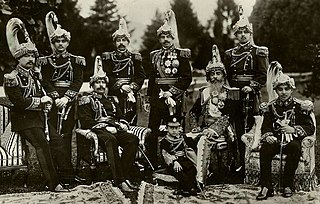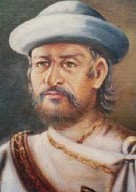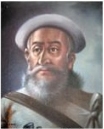
The Kingdom of Nepal was a Hindu kingdom in South Asia, formed in 1768 by the expansion of the Gorkha Kingdom, which lasted until 2008 when the kingdom became the Federal Democratic Republic of Nepal. It was also known as the Gorkha Empire, or sometimes Asal Hindustan. Founded by King Prithvi Narayan Shah, a Gorkha monarch who claimed to be of Khas Thakuri origin, it existed for 240 years until the abolition of the Nepalese monarchy in 2008. During this period, Nepal was formally under the rule of the Shah dynasty, which exercised varying degrees of power during the kingdom's existence.

The Rana dynasty were a Chhetri dynasty that imposed authoritarianism in the Kingdom of Nepal from 1846 until 1951, reducing the Shah monarch to a figurehead and making the Prime Minister and other government positions held by the Ranas hereditary. They are Kshatriya, whose ancestors were descended from the Ranas of Udaipur, Rajasthan, India. The Rana dynasty is historically known for their iron-fisted rule. This changed after the Revolution of 1951 with the promulgation of a new constitution, when power shifted back to the monarchy of King Tribhuvan.

Basnyat/Basnet family or Basnyat/Basnet dynasty was a Khas-Chhetri and a warlord clan family involved in the politics and administration of the Gorkha Kingdom and Kingdom of Nepal. This family got entry into Thar Ghar aristocracy group of Gorkha at the time of King Prithvi Narayan Shah. It was one of the four noble families to be involved in active politics of Nepal together with Shah dynasty, Pande family and Thapa dynasty before the rise of Rana dynasty. This family is descended from Shivaram Singh Basnyat, the commander of Gorkhali forces and a member of Shreepali Basnyat clan of Gorkha. This family was maritally linked to Kala (Black) Pande section of Pande dynasty through Chitravati Pande who married Kaji Kehar Singh Basnyat. This family was the last Kshatriya (Chhetri) political family to be wiped out from the central power by Jung Bahadur Rana of Kunwar family during the Bhandarkhal Massacre in 1846 for the conspiracy to take the power leading to people suffering from the Rana rule for 104 long years.

The Government of Nepal is the federal executive authority of Nepal. Prior to the abolition of the Nepali monarchy in 2006, it was officially known as His Majesty's Government.

Damodar Pande was the Mulkaji of Nepal from 1803 to 1804 and most influential Kaji since 1794 to his death on March 13, 1804. He is also arguably referred to as the first Prime Minister of Nepal. He was the youngest son of famous Kaji of Prithivi Narayan Shah Kalu Pande. He was born in 1752 in Gorkha. Damodar Pande was one of the commanders during the Sino-Nepalese War and in Nepal-Tibet War. And he was among successful Gorkhali warriors sent towards the east by Prithivinarayan Shah.

Kaji was a title and position used by nobility of Gorkha Kingdom (1559–1768) and Kingdom of Nepal between 1768 and 1846. Many other contemporary kingdoms used the same title for their ministers.

Abhiman Singh Basnet/Basnyat was first Commander-in-Chief of Unified Nepal. Abhiman Singh became the first Commander in Chief of a United Nepal after General Kalu Pande died during his second attempt to capture Kirtipur.
Kaji Biraj Thapa Magar played an important role in the Gorkha Kingdom. His leadership, prudence and courage all exhibit he was one of the important Gorkha Bhardars that helped Narbaupal Shah become King of Gorkha. He may also be seen as a 'King Maker' in the modern day term. According to different genealogies, he had taken Narabhupal Shah and his mother Malikavati in custody for three months. The Queen Mother and her son were secretly protected at his residence. After the death of his grandfather, Narabhupal Shah became the King of Gorkha in 1716 and died in 1743. His son, King Prithvi Narayan Shah, succeeding him began unification of small principalities to found modern Nepal.

Vamshidhar Pande known by Alias Kalu Pande was a Nepalese politician and military general who was appointed as Kaji of The Gorkha Kingdom. He was born in 1713 A.D. in Gorkha. He was the commander of the Gorkhali forces during the Unification Campaign of Nepal who died in the first Battle of Kirtipur in 1757 A.D. Pande's real name was Banshidhar Pande. He was a son of Kaji Bhimraj Pande who was minister during reign of King Prithivipati Shah of Gorkha. He was descendant of Minister of Gorkha and Dravya Shah's accomplice Ganesh Pande. He had three sons: Dewan Kajisaheb Vamsharaj Pande, Sardar Ranasur Pande and Mulkaji Sahib Damodar Pande.

Kehar Singh Basnyat or Kehar Singh Basnet was a Nepalese military commander and warhero who laid down his life in the Unification battles of Nepal. He was born in the illustrious clan of Shreepali Basnyats as a member of Kshettriya (warrior) class.

Ram Krishna Kunwar or Ramakrishna Kunwar was military commander (Sardar) of Gorkha Kingdom during the Unification of Nepal at the reign of King Prithvi Narayan Shah. He was born circa 1728 AD to Ashiram Kunwar in the Kunwar family. His descendants went on to found the Rana dynasty of Nepal. He was a successful general in the unification campaign of Nepal of King Prithvi Narayan Shah. He defeated British forces at Hariharpur Gadhi on 25 August 1767. He died in Mechi Campaign in 1771 A.D.

Vamsharaj Pande was a Nepalese politician, military officer and minister of state. He was a significant army commander of Kingdom of Nepal in the second half of 18th century. He was a follower of Bahadur Shah of Nepal and had a significant rivalry with Swaroop Singh Karki.

Kirtiman Singh Basnyat was Mul Kaji of the Royal Court of Nepal between 1794 and his death on 28 September 1801. He was a military commander of the Nepalese Army.
Ganesh Pandey or Ganesa Pande
Bir Bhadra Thapa or Birabhadra Thapa also spelled Virabhadra or Virbhadra, was a politician, courtier and military officer in the Gorkha Kingdom during the 18th century. Born in medieval Tanahun Kingdom, he left his ancestral property there and migrated into the uprising Gorkha Kingdom. He got entry into the minor ranks of military of King Prithvi Narayan Shah due to being a nephew of Sura Prabha, the wife of military commander Shivaram Singh Basnyat of the Basnyat dynasty. Thereafter, he took part in the various battles of Unification of Nepal throughout his life. Among his grandsons, Bhimsen Thapa went on to become the Mukhtiyar of Nepal for 31 years and founder of Thapa dynasty.

Thapa dynasty or Thapa noble family also known as Dynasty of Borlang was a Chhetri political family that handled Nepali administration affairs between 1806 and 1837 A.D. and 1843 to 1845 A.D. as Mukhtiyar. This was one of the four noble families to be involved in the active politics of the Kingdom of Nepal, along with the Shah dynasty, Basnyat family, and the Pande dynasty before the rise of the Rana dynastyor Kunwar family. At the end of 18th century, Thapas had extreme dominance over Nepalese Darbar politics alternatively contesting for central power against the Pande family. Bir Bhadra Thapa was a Thapa of Chhetri group and leading Bharadar during Unification of Nepal. His grandson Bhimsen Thapa became Mukhtiyar of Nepal and established Thapa dynasty to the dominating position of central court politics of Nepal.

The Pande family or Pande dynasty was a Rajput-Chhetri political family that directly ruled Nepali administration affairs from the 16th century to 19th century as Mulkaji and Mukhtiyar. This dynasty/family was one of the four noble families to be involved in active politics of Nepal together with Shah dynasty, Basnyat family and Thapa dynasty before rise of Rana dynasty. Pande dynasty is the oldest noble family to hold the title of Kaji. This family was decimated from political power in 1843 CE in the political massacre by Prime Minister Mathabar Singh Thapa as a revenge for his uncle Bhimsen's death in 1839.
Swarup Singh Karki or Swaroop Singh Karki, was a Nepali politician, courtier, military commander and minister. He was popular for his singing prowess and court conspiracies. He was selected as Dewan in the reign of King Pratap Singh Shah and a significant politician in the regent rule of Queen Rajendra of Nepal. He was one of the most influential court politician in the rule of King Pratap Singh and Queen Rajendralaxmi others being his rival Bahadur Shah of Nepal and Vamsharaj Pande. Vamsharaj was his perceived career rival. His life and career ended when Prince Bahadur Shah was appointed as regent in 1785.
Bilas Kumari Devi was the Queen of Salyan State. Born to King Prithvi Narayan Shah and Indra Kumari Devi, she is best remembered for her contributions to her father's Unification of Nepal campaign.













